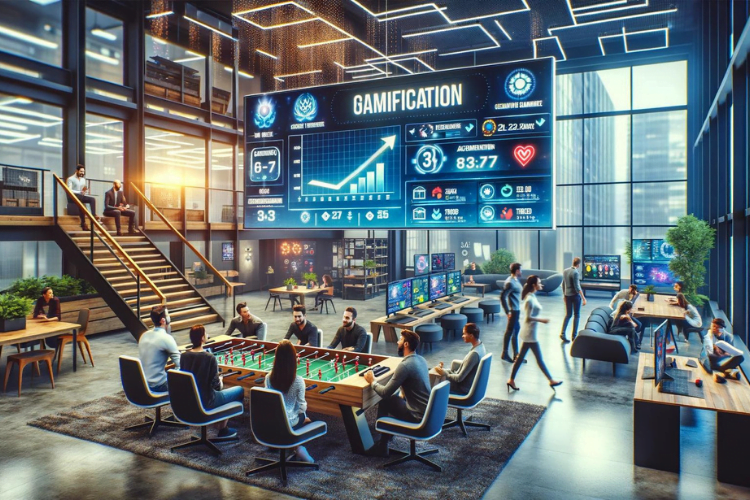Why Storytelling Is the Secret Sauce of Gamification

(And How It Supercharges User Engagement)
Let’s get one thing straight: gamification without storytelling is like a game of Monopoly with all the properties removed—technically playable, but emotionally flat. Sure, you might still move pieces around, but what’s the point if there’s no thrill of the chase or the satisfaction of building an empire?
In the world of gamification, storytelling isn’t just fluff. It’s structure. It’s emotion. It’s purpose. And more often than not, it’s the difference between users going through the motions and users actually giving a damn.
So, why does storytelling matter so much in gamified systems? And how does it boost engagement, motivation, and even learning retention? Let’s unravel the story behind the stories.
The Human Brain is Hardwired for Story
You’ve probably heard this before, but it bears repeating: humans are storytelling animals. From cave paintings to TikToks, we’ve always used stories to make sense of the world. They give us context. They connect the dots. They add meaning to otherwise disconnected events.
Now apply that to gamification.
A leaderboard shows you who’s on top. A mission shows you what to do. But a story? A story shows you why it matters.
When a user logs into a gamified platform and sees a mission titled “Complete Your Profile,” they might shrug. But frame it as “Step 1 of Your Agent Training: Establish Your Identity Before Entering the Field”—suddenly it’s not just admin. It’s the beginning of a journey. And people don’t skip the beginning of a good story.
Narrative Adds Emotional Weight (and That’s a Good Thing)
Here’s the thing: gamification works because it triggers motivation loops—progress, achievement, status, etc. But add narrative on top of that? Now you’ve tapped into emotion, and emotion is a multiplier.
Let’s say your platform includes:
- Missions (e.g., complete tasks or goals)
- Competitions (ranked achievements)
- Tests and quizzes (knowledge checks)
- Articles and videos (learning content)
- A social wall (interaction between users)
Without context, these are just features. But when you wrap them in a narrative—like users being explorers in an unknown world, or agents trying to save their organization from collapse—suddenly, every click, every test, every like or praise, feels like part of something bigger. Users aren’t just completing tasks—they’re progressing through a story arc.
And when people feel emotionally invested, they stay. They push through difficult moments. They even come back for more.
Stories Make Learning Stick
There’s a reason we remember The Tortoise and the Hare but forget half the bullet points from that meeting yesterday. Stories help us retain information better.
Gamification platforms often aim to teach or reinforce behaviors—whether it’s workplace compliance, onboarding, leadership, or even just product knowledge. Storytelling turns this learning into lived experience.
A quiz about cybersecurity is fine. But a quiz embedded in a scenario where the user is a spy choosing between secure and insecure communication channels? That’s sticky. That’s memorable. And, let’s be honest, it’s a lot more fun.
Storytelling Bridges the Gap Between Work and Play
Gamification can sometimes walk a weird tightrope. It’s trying to motivate people to do things that are often… well, not that fun. Like filling out forms. Or completing mandatory training. Or sticking to a routine.
Here’s where storytelling earns its keep.
Instead of gamification feeling like a thin layer of fun on top of something dull, storytelling can reframe the entire experience. Suddenly, tasks aren’t just chores—they’re part of a quest, a challenge, a rite of passage.
A great story makes people forget they’re doing something they “have to” do. Instead, they’re drawn into doing it because they want to know what happens next.
Progress Feels Better When It’s Part of a Journey
Everyone loves progress bars. It’s satisfying to see something move from 0% to 100%.
But what if that progress wasn’t just a number—but a storyline?
Think about it:
- You’re not just completing “Module 3.” You’re preparing for the expedition into enemy territory.
- You’re not just gaining XP. You’re rising through the ranks of the Resistance.
- You’re not just logging in every day. You’re keeping the beacon alive in a dying world.
The narrative arc gives weight to progress. It creates mini-cliffhangers and open loops. And as any good Netflix binge will prove, humans hate unresolved loops. We have to see what happens next.
Characters Create Connection
Now let’s talk about characters. Because yes—storytelling isn’t just plot. It’s people.
Introducing fictional guides, rivals, or allies in your gamified system can bring personality and relatability to the experience. Even a simple mascot that pops up during achievements can help humanize the platform.
Motivacraft, for instance, has begun using character-based storytelling in some of its more advanced experiences. Picture this: you crash-land on a mysterious island. Each completed mission reveals more about your surroundings, and you slowly build relationships with the island’s inhabitants. The same platform mechanics—missions, points, activities—are now seen through an adventure lens. Engagement soars.
Characters can reflect the user’s journey, serve as aspirational figures, or even deliver feedback in a more playful way. It’s a smart move, especially when trying to soften the sting of failure or nudge users forward.
It’s Not Just Fun—It’s Strategic
Here’s a secret: storytelling isn’t just about making gamification cooler. It actually helps with clarity, coherence, and content retention.
With a strong narrative frame:
- Users are less confused about where to go next
- They’re more likely to complete long-term programs
- They can more easily explain what they’re doing and why
In other words, a good story doesn’t just make things fun—it makes them work better.
It can also help with internal buy-in. When you present a gamified initiative to stakeholders, it’s way easier to say, “We’re guiding users through a transformation journey where they level up their skills,” than, “We’re using points and badges to drive engagement.”
Real Engagement Is About Meaning
We throw the word “engagement” around a lot. But let’s break it down.
True engagement isn’t just “users are clicking buttons.” It’s users feeling like their actions matter. That they’re progressing toward something meaningful. That their presence counts.
Storytelling is how you infuse that meaning.
It’s what makes a user think, “I’m not just doing a task—I’m contributing to the outcome of this story.” That’s powerful. That’s sticky. That’s engagement that lasts longer than a campaign or a season.
Let’s Be Honest—We’re All Tired of Dry
Corporate learning platforms. Employee portals. CRM systems. Most of them are functional but forgettable. And often, they feel like glorified spreadsheets.
But when you inject a story—something with characters, stakes, and suspense—everything changes. You catch people off guard. In a good way.
Imagine your platform being the one that surprises people with how engaging it is. That delights them with something unexpected. That makes them say, “I actually look forward to using this.”
That’s the power of storytelling in gamification.
How Motivacraft Does It Differently
At Motivacraft, storytelling isn’t an afterthought. It’s built right into the core experience.
From themed missions and seasonal storylines to immersive narratives like Marooned: A Pilot’s Tale, users don’t just interact with content—they live through it.
Here’s what Motivacraft brings to the table:
- Customizable Story Arcs: Companies can align stories with onboarding, learning tracks, or cultural values.
- Visual Storytelling: Characters, locations, and quests come alive with rich visuals and scene transitions.
- Integrated Progression: As users complete real tasks, the story moves forward—unlocking new chapters or characters.
- Emotional Anchoring: Narratives are crafted to mirror the user’s growth, building connection and reflection.
And let’s be clear: this isn’t just about aesthetics. We’ve seen it move the needle on engagement rates, content retention, and even internal culture. People talk about the stories. They reference characters. They feel part of something.
So, Is Storytelling the Future of Gamification?
Well, not just the future. It’s already happening.
From Duolingo’s sassy owl to narrative-driven fitness apps like Zombies, Run!, we’re seeing a clear trend: when people feel like they’re part of a story, they care more. They do more. And they remember more.
If you’re building or managing a gamified platform and haven’t woven in a narrative yet, now’s the time. Even small touches—naming missions creatively, adding a mentor character, framing progress as a journey—can have a big impact.
And if you want to go all in? Platforms like Motivacraft make it easy to build full-blown story experiences that actually align with your goals.
Final Thought: Don’t Just Add Story—Tell One Worth Telling
Look, not all storytelling is good storytelling. Slapping a medieval fantasy theme onto your tax compliance module isn’t going to win hearts unless it’s done thoughtfully.
But if you anchor your stories in user identity, real emotion, and clear progress, you can turn your gamified system from a tool… into an adventure.
And honestly? That’s where the magic happens.


